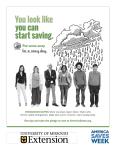COLUMBIA, Mo. – Small changes can mean big savings at the supermarket, says a University of Missouri Extension nutrition specialist.
The average American throws away $600 worth of food each year, said Ellen Schuster. Before you leave home, shop your own cupboards, refrigerator and freezer.
Make a menu and shopping list after checking grocery ads and coupons. Loss leaders—items sold at a loss to the store—are used to attract buyers who likely will buy other items while there. They’re a great buy only if you use them, Schuster said.
Shop quickly. “Get in and get out,” she said. “The more time you spend in the store, the more you are going to spend.” Shoppers typically spend $2.17 every minute they are in the store, according to the Food Marketing Institute. A grocery list helps prevent impulse buying.
Shop the store’s perimeter aisles first. That’s where you’ll find the most nutritious foods such as produce, meat and dairy. Use shelf labels or your smartphone calculator to compare unit prices.
Often the best bargains are hiding on shelves that aren’t at eye level, she said. “Look high. Look low.”
Consider buying store brands. They can be 20 to 50 percent cheaper than name-brand items. Store-brand items are usually just as nutritious and tasty as name brands. But sales and coupons can often make name brands a bargain, so it’s important to compare.
Other tips from Schuster:
• Don’t shop when you’re hungry. You’ll be tempted to buy more.
• Check container sizes and compare unit pricing. In recent years, manufacturers have changed container sizes on many items so you pay the same for less.
• Frozen items usually are just as nutritious as fresh items and can be cheaper. Canned items, while generally less expensive, may contain large amounts of sodium.
• Buy local when you can for the best nutrition value.
• Don’t take children on your shopping trip, if possible. This helps you avoid impulse buying.
• Buy in bulk only if you are going to use the item before it goes bad. Although the unit cost may be lower, it’s a good buy only if you can use the larger quantity. Staples such as flour and sugar are examples of items that may be good bulk purchases, while perishable items such as produce or dairy may not be.
• Don’t buy large quantities unless you need them. If a sale is advertised as “Buy 10 for $10,” you can usually buy only one and get it for the $1 unit price.
• There are times when you may need to buy costly convenience items such as precut fruit and vegetables. But, for the most part, convenience is costly, Schuster said. A little extra work will result in big savings and better nutritional value.
• Buy nonfood products such as cleaning supplies and personal care items from discount stores.
• Eliminate processed foods low in nutritional value. Not only are these items less filling and bad for you, they generally cost more.
MU Extension offers feature articles and other resources on food, fitness and your budget at missourifamilies.org/features/nutritionarticles/budget.htm and missourifamilies.org/toughtimes/foodfitness.htm.
Read more http://extension.missouri.edu/news/DisplayStory.aspx?N=2160






